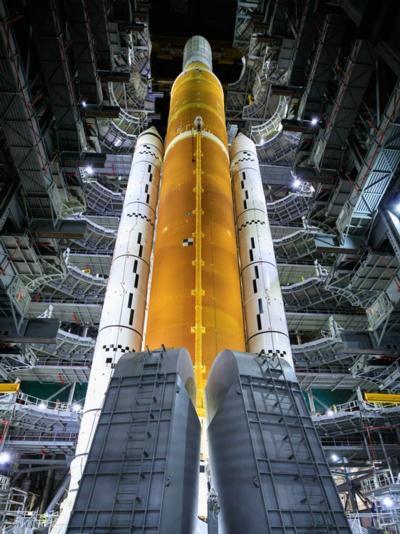Sun, Dec 05, 2021
Solid Rocket Launch Systems To Be Used in Artemis and Beyond
NASA has awarded the Booster Production and Operations Contract to Northrop Grumman for the agency's upcoming Space Launch System rockets. The launch system will be the primary system for use in the first 3 Artemis missions, with likely inclusion for the 4th.

The contract comes in at a value of $3.19 billion, finalizing a contract awarded in 2020 that authorized Grumman to build the labor-intensive, expensive twin boosters for the next 6 SLS flights. The contract stands through 2031 and includes all the necessary flight materials and support equipment, as well as operations for the SLS. Artemis missions IV-VIII will see benefits of the design, development, testing, and evaluation of the boosters, with Artemis IX seeing bolstered specifications under the Booster Obsolescence and Life Extension (BOLE) program. The twin solid rocket boosters will account for more than three quarters of the thrust for each SLS launch, mounted on the sides of the core stage. Their design builds on the older space shuttle rocket systems, with an additional segment vital to lifting the increased payload. The BOLE design process is expected to update the current system's steel casing with a stronger, lighter composite case, upgraded structures, electronic thrust vectoring,
and improved propellant materials.
The deal is a superb win for Grumman, snapping up what is essentially the spinal column of NASA's future deep space exploration. Without the SLS rocket and Orion spacecraft, NASA would lack critical mission capabilities to land the first woman and person of color on the surface of the moon. Eventually, those missions are hoped to give way to a long-term lunar presence that serves as a stepping stone on the way to Mars.
“Our boosters are ready to launch the first flight of the Space Launch System on the Artemis I mission, and we are making great progress producing boosters for the Artemis II, III, and IV missions,” said Bruce Tiller, NASA's SLS booster manager. “Upgrading the booster’s performance ensures we can improve SLS’s ability to send astronauts and cargo to the Moon as well as making our processes more efficient.”
More News
From 2023 (YouTube Edition): "Ain’t Your Daddy’s Super Cub”—Don Wade Co-owned by Don and Ron Wade—the former of Don’s Dream Machines, a storied >[...]
Pilot-Rated Passenger Reported That The Pilot Did Not Adequately “Round Out” The Landing Flare And The Airplane Bounced And Yawed To The Right Analysis: The pilot state>[...]
Dead Reckoning Dead reckoning, as applied to flying, is the navigation of an airplane solely by means of computations based on airspeed, course, heading, wind direction, and speed,>[...]
Aero Linx: Lake Amphibian Club This website is created and sponsored by the Lake Amphibian Club, to help spread the word about these wonderful, versatile amphibians that can land j>[...]
“I am deeply honored to be sworn in as NASA administrator. NASA’s mission is as imperative and urgent as ever — to push the boundaries of human exploration, ignit>[...]
 Classic Aero-TV: In Praise of Alabamas Patriot Aircraft USA
Classic Aero-TV: In Praise of Alabamas Patriot Aircraft USA NTSB Final Report: Cirrus Design Corp SR22
NTSB Final Report: Cirrus Design Corp SR22 ANN's Daily Aero-Term (12.21.25): Dead Reckoning
ANN's Daily Aero-Term (12.21.25): Dead Reckoning ANN's Daily Aero-Linx (12.21.25)
ANN's Daily Aero-Linx (12.21.25) Aero-News: Quote of the Day (12.21.25)
Aero-News: Quote of the Day (12.21.25)



